|
Location:
�rencik, 15 km NE from Urfa.
Turkey. |
Grid Reference:
37�
13' 22" N. 38� 55' 51" E |

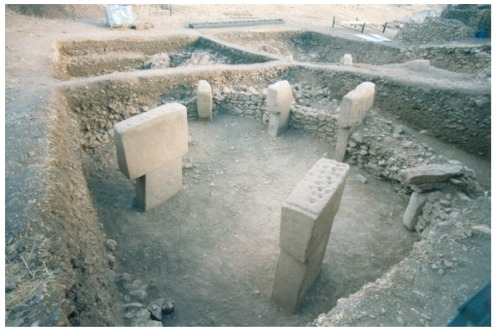 G�bekli
Tepe:
(Temple/Shrine Complex). G�bekli
Tepe:
(Temple/Shrine Complex).
This is the site of the worlds
currently known oldest shrine or temple complex in the world, and the
planet's oldest known example of monumental architecture. It has also
produced the oldest known life-size figure of a human.
Compared to Stonehenge, Carnac or the Pyramids of Egypt, these
are relatively humble megaliths. None of the circles excavated (four out of an
estimated 20) are more than 30 meters across. What makes the discovery
remarkable are both the exquisite and intricate carvings of boars, foxes, lions,
birds, snakes and scorpions,
and their age. Dated at around 9,500 BC, these stones are 5,500 years older than
the first cities of Mesopotamia.
|
Gobekli Tepi: ('Hill with a Belly', 'Navel Mound'). |
"First came the temple, then the city"
 Description
-
As there is
no evidence of habitation; the structures are interpreted as
temples. After 8000 BC, the site was abandoned and purposely
covered up with soil. (1)
It is thought that the hill top was a site of
pilgrimage for communities within a radius of roughly a hundred
miles. The tallest stones all face southeast, Description
-
As there is
no evidence of habitation; the structures are interpreted as
temples. After 8000 BC, the site was abandoned and purposely
covered up with soil. (1)
It is thought that the hill top was a site of
pilgrimage for communities within a radius of roughly a hundred
miles. The tallest stones all face southeast,
In the Jan. 18 issue of the
journal 'Science', German archaeologist Klaus
Schmidt is interviewed about his work at the 11,000-year-old site of
Gobekli Tepe ("navel hill") in Turkey.
According to Andrew Curry, the
author of the Science article, Gobekli Tepe
is situated on the most prominent hilltop for miles around. It
consists of at least 20 underground rooms that contain a number of
T-shaped stone pillars that are 8 feet tall and weigh about 7 tons.
The pillars are engraved with images of animals, including leopards,
snakes and spiders.
This is not a place where people
lived. It's as far away from water as you can get in this region.
Instead, it's a place of ceremony. And, according to Schmidt, it's
"the first manmade holy place."
Ref: (http://www.dispatch.com/)
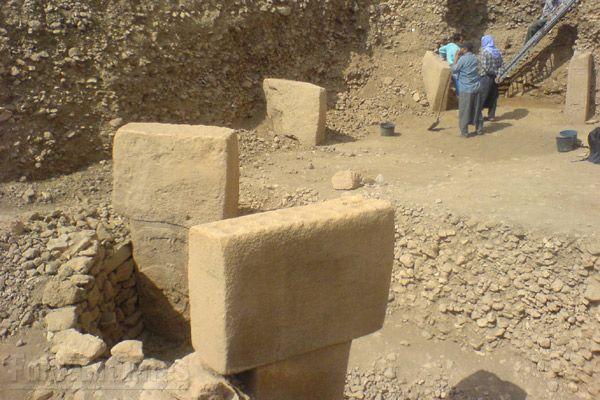
Article: TIME:
DECEMBER 6, 1999 VOL. 154 NO. 23.
By MARYANN BIRD Gazientep.
'An ancient place of worship - a cult site carbon-dated to
the second half of the 9th millennium BC. Gobekli Tepe is as good a
point as any to begin a diverse archaeological tour of Turkey, a country
astonishingly rich with the remains of scores of civilizations and
empires stretching from caveman days to the early 20th century'.
"This place is as important as the discovery of 14,000
B.C. cave art in France," says Harald Hauptmann, the team leader and
director of the German Archaeological Institute in Istanbul. Gobekli
Tepe reflects what the experts say is a turning point from the
Epi-paleolithic to the Early Neolithic era in upper Mesopotamia - that is,
the time when early man was just beginning to control nature, before the
advent of food production, until the first domestication of plants and
animals'.
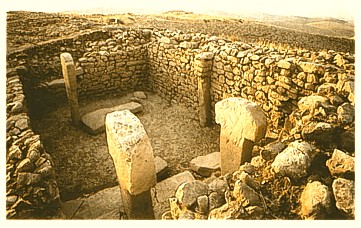 "In this site and the one at Nevali Cori, 45 km northeast of
here," says Hauptmann, "we have found an art we never knew before--not
on cave walls but in public buildings, with sculpture and painted
haut-reliefs [sculpted stone panels]. "In this site and the one at Nevali Cori, 45 km northeast of
here," says Hauptmann, "we have found an art we never knew before--not
on cave walls but in public buildings, with sculpture and painted
haut-reliefs [sculpted stone panels].
What we have ascertained is that art is not something someone just
invented one day, like the wheel or fire. It has always been an active
part of the human psyche, since the very beginning."
At Gobekli Tepe, 15 km northeast of the city of
Sanliurfa, stand four megalithic limestone pillars, 7 m tall and
weighing perhaps 50 tons each.
 'Two of them bear the image of a snarling lion defending
what Hauptmann believes to be a cult sanctuary or shrine. Erected
without the aid of domesticated animals 6,000 years before giant
structures were built in Pharaohic Egypt, the pillars suggest that early
Neolithic workers knew how to use poles, boards and pulleys to handle
huge stones'. 'Two of them bear the image of a snarling lion defending
what Hauptmann believes to be a cult sanctuary or shrine. Erected
without the aid of domesticated animals 6,000 years before giant
structures were built in Pharaohic Egypt, the pillars suggest that early
Neolithic workers knew how to use poles, boards and pulleys to handle
huge stones'.
Hauptmann's site also features a unique floor relief of
a squatting woman--perhaps giving birth--reliefs of a variety of
animals, and a field of flint chips, indicating the site also hosted a
fairly sophisticated tool- and weapon-producing operation.
Ref: (TIME EUROPE .DECEMBER 6, 1999 VOL. 154 NO.
23)
Architecture:
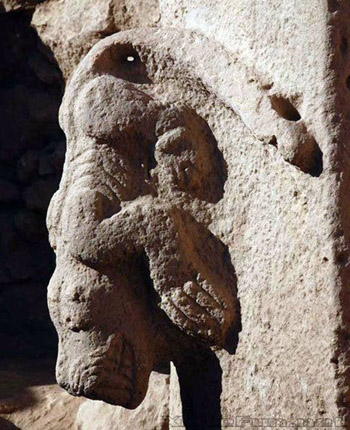 'The houses or temples are round
megalithic buildings. The walls are made of unworked dry stone and
include numerous T-shaped monolithic pillars of limestone that are up
to 3 m high. Another, bigger pair of pillars is placed in the centre
of the structure. The floors are made of Terrazzo (burnt lime), and
there is a low bench running along the whole of the exterior wall'. 'The houses or temples are round
megalithic buildings. The walls are made of unworked dry stone and
include numerous T-shaped monolithic pillars of limestone that are up
to 3 m high. Another, bigger pair of pillars is placed in the centre
of the structure. The floors are made of Terrazzo (burnt lime), and
there is a low bench running along the whole of the exterior wall'.
'The reliefs on the pillars
include foxes, lions, cattle, wild boars, herons, ducks, scorpions,
ants and snakes. Some of the reliefs have been deliberately erased,
maybe in preparation for new pictures. There are freestanding
sculptures as well that may represent wild boars or foxes. As they are
heavily encrusted with lime, it is sometimes difficult to tell.
Comparable statues have been discovered in
Nevalı �ori. The
quarries for the statues are located on the plateau itself, some
unfinished pillars have been found there in-situ. The biggest
unfinished pillar is still 6.9 m long, a length of 9m has been
reconstructed'.
'The construction of the G�bekli
Tepe complex implies organisation of a degree of complexity not
hitherto associated with pre-Neolithic societies. The archaeologists
estimate that up to 500 persons were required to extract the 10-20 ton
pillars (in fact, some weigh up to 50 tons) from local quarries and
move them 100 to 500m to the site'. (Ref:
http://en.wikipedia.org/)
(The
top-50 Stones of all time)

So far, 40-odd standing stones (two to four metres
high) have been dug out. They are T-shaped and arranged in enclosed
circles, which cover several hundred square metres. However, a broken,
half-quarried stone has been found in a limestone bed about a
kilometre from the main site. It is nine metres long, and was
obviously intended to join the pillars at Gobekli: so there may be
other stones, as yet unearthed, that are this big. Geomagnetic surveys
imply that there are at least 250 more standing stones buried at the
site.
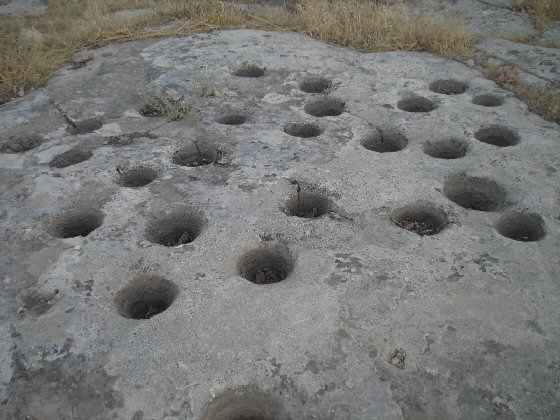
The T-shaped monoliths appear to be
covered with cup-marks on their top-sides. Their purpose is completely
unknown. These larger holes in a stone in the ground are reminiscent
of the ''oracle' stones in front of the
Hal Tarxien on Malta.
Chronology:
The site has yielded dates as far back as
7,500 BC - 7,000 BC.
(1)
Around the beginning of the 8th
millennium BC, "Navel Mountain" lost its importance. The advent of
agriculture and animal husbandry brought new circumstances to human
life in the area. But the complex was not gradually abandoned and
simply forgotten, to be obliterated by the forces of nature over time.
Instead, it was deliberately covered with 300 to 500 cubic metres of
soil. Why this happened is unknown, but it preserved the monuments for
posterity.
The most recent building phase at G�bekli Tepe (Level II)
has been dated both comparatively and absolutely (C14) to ca 8,000 BC,
with an earlier primary building phase (Level III) ending as early as
9,000 BC. The age of the earliest occupation cannot yet be determined;
the depth of the deposit, however, would suggest a period of several
millennia, which signifies that the site had already existed in early
Palaeolithic times.
Photo Gallery: Gobekli Tepe:

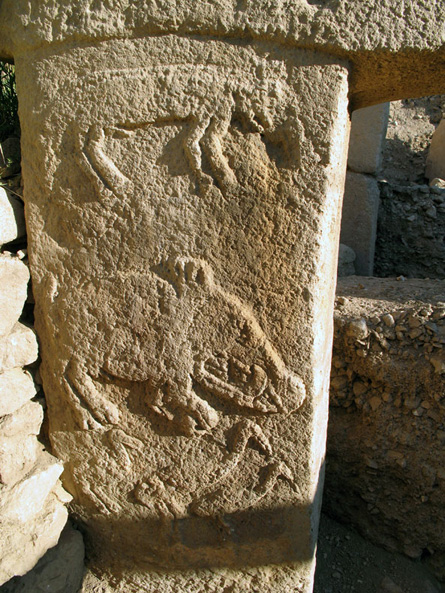
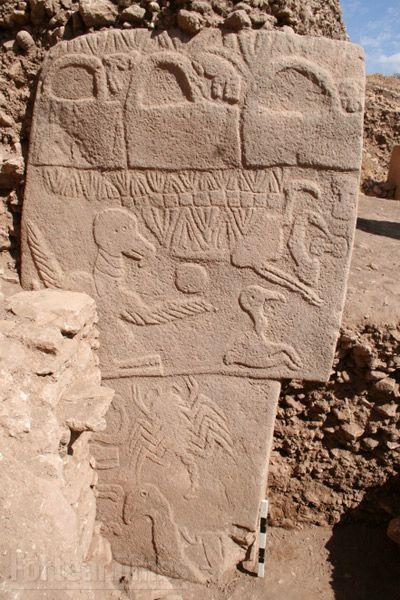
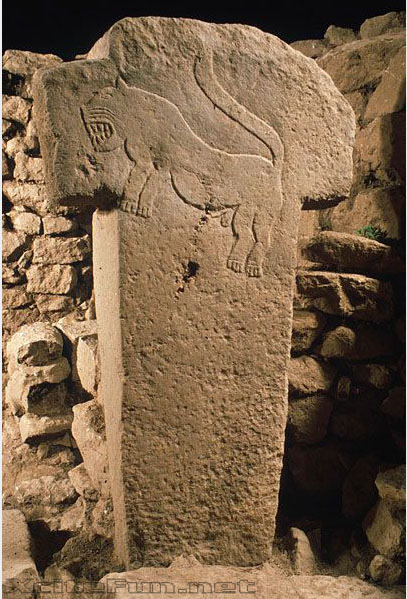
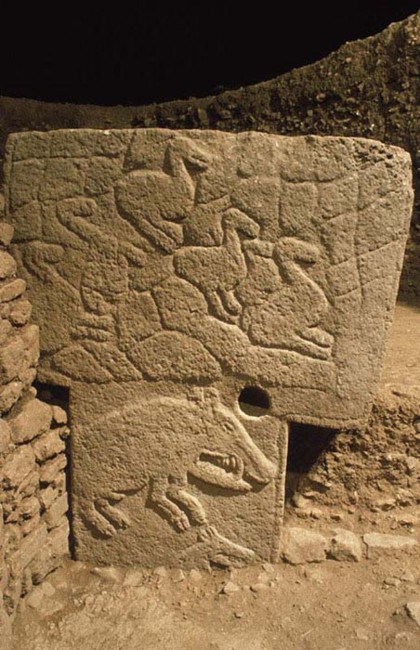

Right: The same arms as seen in the
'cult temple'' at Nevali Cori....Note the
face on the thin side of the stone.
Other Interesting Discoveries
at Gobekli Tepe:
|
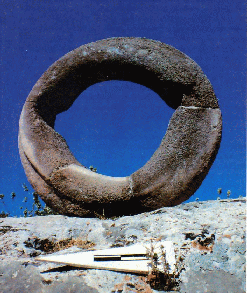
Above: Stone-carved ring.
(Other Examples of
Holed-Stones)
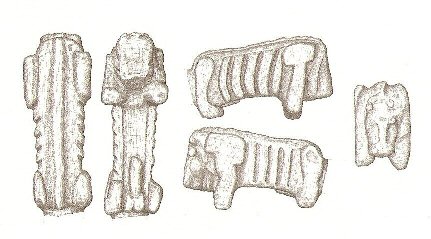
Carved figurine of animal.
 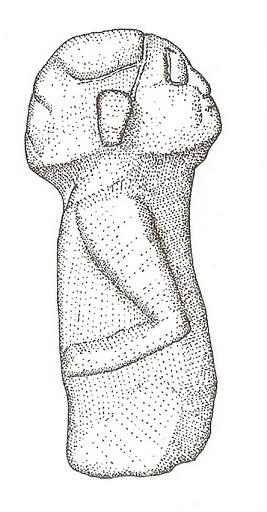
Left:
Snake, Tree and Person..?, Right: Two-faced carved
figurine.. |

Life-sized Human Figurine. |
|
Other Nearby Sites of Interest:
Karahan Tepe, a site
only discovered in the late 1990s and still awaiting full excavation.
This is located near Sogmatar on the Harran Plain, and dates back 11,000
years at least. Already a large number of T-Shaped pillars and stone
rows have been uncovered here.
Karahan Tepe lies 60 km east from Urfa in an
area called Tektek Daglari. Some 266 in situ pillars (Like the G�bekli
pillars...only smaller) cover the field and are visible 50-60 cm above
ground level. The rest of the pillars are still covered under the earth.
|
|